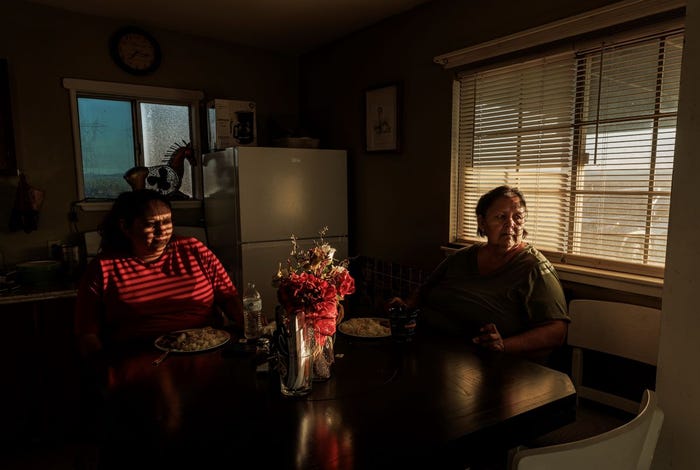In the Shadows of Arizona’s Data Center Boom, Thousands Live Without PowerIn the Shadows of Arizona’s Data Center Boom, Thousands Live Without Power
As data centers drain America’s power grids, a fierce battle is being waged for electricity. On Navajo Nation land, many are on the losing end.
December 26, 2024

CAMERON, Ariz. - Living on one of the largest swaths of land in America without electric power, Thomasina Nez’s entire life is a scramble to complete basic tasks.
To take a hot shower, she must wait for buckets of water to come to a boil on a small propane stove outside her wood-framed roundhouse. To make meals, she relies mostly on canned goods because unrefrigerated produce rots quickly in the Arizona heat. It’s a struggle to stay warm at night, because she refuses to use her coal-powered heater after its fumes killed her two dogs.
A fierce battle for electric power is being waged across the nation, and Nez is one of thousands of people who have wound up on the losing end. Amid a boom in data centers, the energy-intensive warehouses that run supercomputers for Big Tech companies, Arizona is racing to increase electricity production. In February, the state utility board approved an 8 percent rate hike to bolster power infrastructure throughout the state, where data centers are popping up faster than almost anywhere in the United States. But it rejected a plan to bring electricity to parts of the Navajo Nation land, concluding that electric customers should not be asked to foot the nearly $4 million bill.
“We’ve been without [power] for quite a long time,” said Nez, who lives separately from her teenage children so they have electricity to complete their schoolwork. Tech companies “already have it,” she said, “and for them to get more power, it’s kind of not right.”

Nez stands in front of a trailer home, where her brother lives, and the traditional Navajo home that she lives in. Credit: Adriana Zehbrauskas for The Washington Post
Nicole Garcia, a spokeswoman for Arizona’s utility board the Arizona Corporation Commission (ACC), said it did not approve the Navajo aid provision because of “concerns about how the funds would be used,” adding that customers are not “responsible for extending electricity to all tribal areas of the state.”
Ann Porter, a spokesperson for the power company Arizona Public Service (APS), said that its process for raising rates is “backward-looking.” The organization aims to “recover money we’ve already spent and better align with the cost to maintain a reliable energy grid for Arizona.”
After a years-long courtship of Big Tech by local politicians, power companies and utility regulators eager for the promise of tax revenue and jobs, the strain on Arizona’s power grid is already apparent. Often, vulnerable communities are paying the price. While Nez and her neighbors lost a shot at getting power, the historically Black town of Randolph, almost 60 miles south of Phoenix, faces the expansion of a massive natural gas plant that emits particulate matter linked to asthma and lung cancer.
In 2022, the Arizona Corporation Commission halted a planned expansion of the gas plant. But the Salt River Project (SRP) appealed, arguing that the plant was crucial to meeting short-term power needs. Randy Miller, a Salt River Project board member not representing the board, said the decision to expand the plant was due in part to the growing demands of data centers.
Though the power company has funded scholarships, road pavings and a community center in Randolph, resident Jeff Jordan, who lives in the shadow of the gas plant and struggles with asthma and heart issues, said he was furious when the ACC approved the expansion, which happened last year after SRP reached a settlement with town representatives.
“We’re already impacted enough,” Jordan said. “But they’re here for one reason and one reason only: and that’s money.”
Angie Bond-Simpson, SRP’s senior director of resource management, said the expansion was driven by many factors, including data centers, advanced manufacturing facilities and a boom in Arizona’s housing sector. SRP has committed to several health protection measures near the plant, including air quality monitoring, reducing its size and moving the plant “further away” from housing, she added.
Nationwide, concern is rising in local communities about the burgeoning data center industry, with residents complaining that the units bring little in the way of jobs or revenue while straining local resources, raising utility prices and forcing communities to return to outdated and environmentally suspect modes of electricity generation, including coal and natural gas.
In drought-ridden Arizona, several towns have passed ordinances deterring tech companies from using water to cool the supercomputers that fuel the artificial intelligence revolution. That has forced the data centers to chill their warehouses with electricity, making the stress on the power grid especially intense, experts said.
Still, power remains relatively cheap in Arizona, and the state has long marketed itself as a marquee destination for data centers. In addition to cheap power, state officials say Arizona’s limited exposure to natural disasters makes it an ideal location for data centers, which need to stay online every minute of the day.
Since 2013, state officials have offered millions in tax incentives to companies that house data center operations in Arizona. The sales pitch has worked. Since 2019, Maricopa County has built 12 data centers, more than any other state except Virginia, California and Texas, according to data provided to The Washington Post by DC Byte.
Arizona’s Maricopa County is on track to having the second largest concentration of data centers in the United States by 2028, behind only Northern Virginia’s Loudoun County. At least 20 data center projects are in the pipeline, according to data analyzed by The Post. Microsoft, Google, Apple and Meta all maintain data centers in the county, which includes Phoenix, while Intel and the Taiwan Semiconductor Manufacturing Company have semiconductor chip facilities.
These projects come amid rapidly increasing electricity needs in the region, where utility officials are struggling to meet demands over the next decade.
Arizona Public Service, the state’s largest utility provider, estimates 55 percent of its future electricity needs will be caused by data centers, according to planning documents reviewed by The Post. The company’s power infrastructure as of 2023 would not support the electricity it needs to generate by 2031, Porter said.
Salt River Project anticipates “about half” of its projected power growth through fiscal year 2029 is due to data centers, Bond-Simpson said in a statement. Miller, the Salt River Project board member, said it’s nearly impossible for utility companies to meet these demands without turning to coal and natural gas plants - sources the power companies had begun phasing out due to environmental hazards.
Utility providers are forging ahead. “It’s our responsibility to provide the critical infrastructure needed to power this unprecedented economic growth we’re seeing here in Arizona,” APS President Ted Geisler said at the February ACC rate hike hearing. Porter said the rate hike is not related to infrastructure needed for future data center customers. If proposed projects require grid upgrades, data center customers would be required to fund them, she added. In December, Phoenix’s city council approved changes to regulate data center growth.
The massive supply gap can occasionally benefit power companies, which can cite the unmet need to advocate for more resources, said Erin Overturf, a clean energy director at the nonprofit Western Resource Advocates, which analyzes Arizona’s energy grid. Regulators typically provide utility companies 8 to 10 percent returns on capital projects, which can make new facility investments a boon for profits, she said.
Eric Orsborn, mayor of Buckeye, Arizona, is aware data centers may stress the power grid. In August, Buckeye’s city council approved a $20 billion data center project to come to town. Orsborn trusts utility companies to come up with the additional energy.
“I’m not worried,” Orsborn said. “It doesn’t all have to be figured out today.”
Still, the 8 percent rate hike will cost power customers in the state an extra $10.50 per month on average - forcing Arizona residents to help foot the bill to meet power demands. Meanwhile, the ACC’s four Republican members decided in February no extra ratepayer dollars should be used to bring power to hundreds of homes in Navajo Nation, arguing that bill should not fall on the shoulders of the power company’s customers. The commission approved $1.25 million in funding in 2021 to provide electricity to Navajo Nation homes and businesses, Garcia added.

Gayle Payton, right, with her daughter, Norma Payton. Credit: Adriana Zehbrauskas for The Washington Post
Though power lines sit within spitting distance of their homes, many Navajo Nation members have been without power for decades. In 1966, the federal government enacted a development ban on the area as part of a land dispute between the Navajo and Hopi tribes. The rule blocked large-scale infrastructure development on Navajo Nation territory, leaving people with poor roads, no electricity and limited water supply.
The freeze was repealed in 2009, but the patchwork of federal and tribal agencies present on Navajo Nation land has made the process of getting power to homes an expensive prospect filled with red tape and delays, advocates said.
Gayle Payton has lived on the Navajo reservation in Cameron for 11 years. Her lungs are fragile from a coronavirus infection in 2021, but she can’t run oxygen equipment on her small generator. Without an at-home system, Payton’s oxygen levels have dropped deathly low eight times over the past two years, she said, forcing her daughter to drive her an hour to the hospital for treatment.
Though power lines loom over her trailer, they feel impossibly out of reach. To connect to the grid, Payton, who lives on $900 a month in social security benefits, would need to pay $4,000 for a feasibility study and a total of $39,895 in building costs, according to APS documents from 2019.
At the February hearing, citizens voiced support for the plan to aid the Navajo Nation. “It’s our time to pay them back,” said Kristin Nelson, a local real estate agent.
But the vote failed, and Payton has no way to pay on her own.
“I said, ‘Forget it: This is crazy,’” she said.
About the Author
You May Also Like









